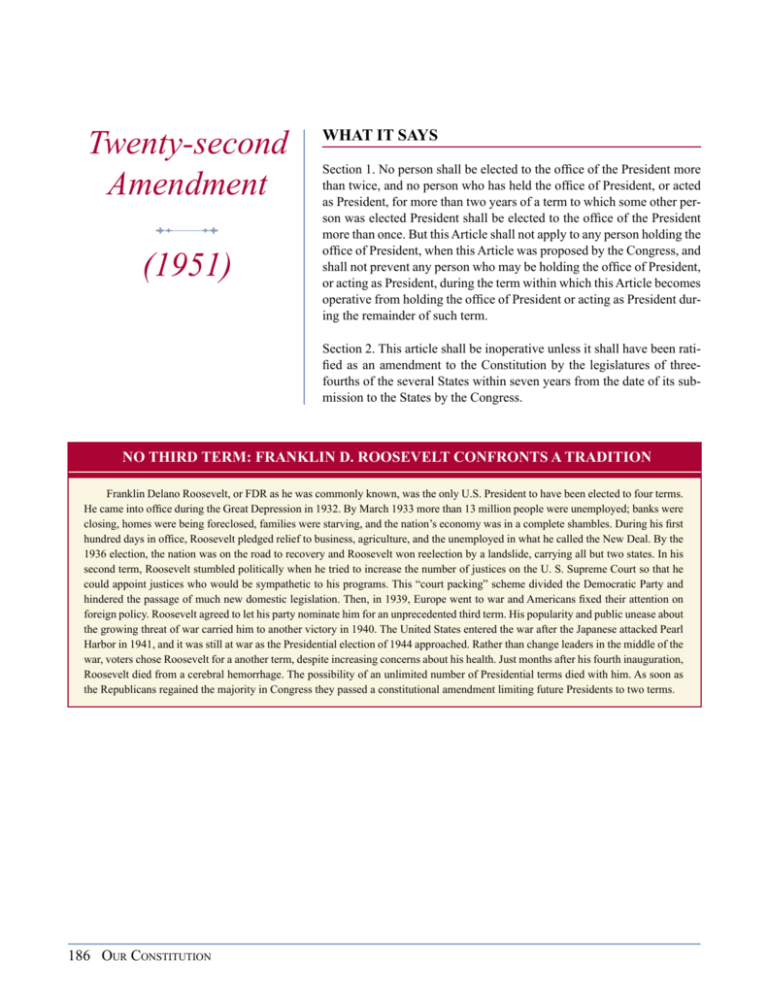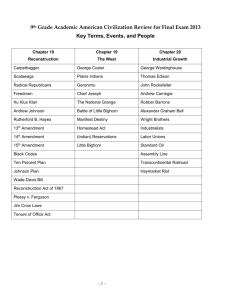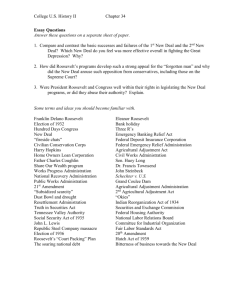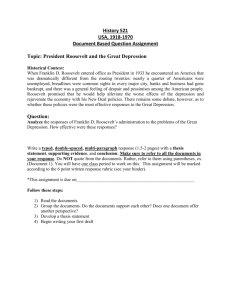Twenty-second Amendment (1951)
advertisement

Twenty-second Amendment (1951) WHAT IT SAYS Section 1. No person shall be elected to the office of the President more than twice, and no person who has held the office of President, or acted as President, for more than two years of a term to which some other person was elected President shall be elected to the office of the President more than once. But this Article shall not apply to any person holding the office of President, when this Article was proposed by the Congress, and shall not prevent any person who may be holding the office of President, or acting as President, during the term within which this Article becomes operative from holding the office of President or acting as President during the remainder of such term. Section 2. This article shall be inoperative unless it shall have been ratified as an amendment to the Constitution by the legislatures of threefourths of the several States within seven years from the date of its submission to the States by the Congress. NO THIRD TERM: FRANKLIN D. ROOSEVELT CONFRONTS A TRADITION Franklin Delano Roosevelt, or FDR as he was commonly known, was the only U.S. President to have been elected to four terms. He came into office during the Great Depression in 1932. By March 1933 more than 13 million people were unemployed; banks were closing, homes were being foreclosed, families were starving, and the nation’s economy was in a complete shambles. During his first hundred days in office, Roosevelt pledged relief to business, agriculture, and the unemployed in what he called the New Deal. By the 1936 election, the nation was on the road to recovery and Roosevelt won reelection by a landslide, carrying all but two states. In his second term, Roosevelt stumbled politically when he tried to increase the number of justices on the U. S. Supreme Court so that he could appoint justices who would be sympathetic to his programs. This “court packing” scheme divided the Democratic Party and hindered the passage of much new domestic legislation. Then, in 1939, Europe went to war and Americans fixed their attention on foreign policy. Roosevelt agreed to let his party nominate him for an unprecedented third term. His popularity and public unease about the growing threat of war carried him to another victory in 1940. The United States entered the war after the Japanese attacked Pearl Harbor in 1941, and it was still at war as the Presidential election of 1944 approached. Rather than change leaders in the middle of the war, voters chose Roosevelt for a another term, despite increasing concerns about his health. Just months after his fourth inauguration, Roosevelt died from a cerebral hemorrhage. The possibility of an unlimited number of Presidential terms died with him. As soon as the Republicans regained the majority in Congress they passed a constitutional amendment limiting future Presidents to two terms. 186 Our Constitution WHAT IT MEANS Nothing in the original Constitution limited the number of terms that a President could serve, but the nation’s first President, George Washington, set a precedent by declining to run for a third term, suggesting that two four-year terms were enough for any President. Washington’s precedent survived until 1940, when Franklin D. Roosevelt, a Democrat who had steered the nation through the Great Depression, ran for a third term on the eve of the Second World War. Roosevelt won a third term in 1940 and a fourth term in 1944. Following Roosevelt’s death in April 1945, just months into his fourth term, Republicans in Congress took the lead in proposing a limit of two terms for future Presidents. The amendment specified that if a Vice President took over for a President but served less than two years of the of the former President’s term, the new president could serve for two full four-year terms. If more than two years of the Presidential term remain when the Vice President assumes office, the new President may serve only one additional term. “I had made plans for myself, plans for a private life [but] my conscience will not let me turn my back on a call to service.” — Franklin D. Roosevelt, explaining his decision to run for a third term, in his acceptance speech to the Democratic Convention in 1940 Twenty-Second Amendment 187 War Powers TIMELINE First President steps down after two terms Thomas Jefferson steps down after two terms Grant considers a third term 1797 1809 1875 President George Washington is still widely admired when he completes his second term as President, and many hope that he will run for a third term. Washington declines on the grounds that an orderly transition of authority is necessary to prevent rule by a king-like power.Washington also grew sensitive to the increased partisanship and resulting newspaper attacks on his administration during his second term, which made him anxious to retire to Mount Vernon. After defeating John Adams in his run for reelection, Thomas Jefferson goes on to serve two terms as President. Jefferson then steps down voluntarily, solidifying the tradition of Presidents serving only two terms. As President Ulysses S. Grant, a Republican, nears the end of his second term in the White House, he contemplates running for a third term. The House of Representative, where the Democrats hold the majority, pass a resolution denouncing a third term as a violation of American political tradition. Grant chooses not to be a formal candidate, but stands ready to be drafted in 1876 and 1880. His party chooses other candidates. FDR elected for a fourth term Republicans win control of Congress and change the constitution Truman chooses not to run for a third term 1944 1946 1952 In the midst of the Second World War, Franklin Delano Roosevelt runs for an unprecedented fourth term. His Republican opponent, New York governor Thomas Dewey, chooses not to criticize the President’s handling of the war, but instead questions his ability to lead the nation given his age and health, calling Roosevelt “a tired old man.” The strategy fails and Roosevelt is returned to office one last time, but he dies only four months into this fourth term, in April 1945. For the first time since the beginning of the depression, Republicans win control of both the Senate and House of Representatives in 1946. Among the party’s chief objectives is a constitutional amendment that will prevent another President from running for more than two terms.With the support of President Harry Truman, who took office in 1945 after Franklin Roosevelt’s death, Congress approves the Twenty-second Amendment and sends it to the states, with a seven-year deadline for ratification. The Twenty-second Amendment specifically exempts the incumbent President, Harry Truman. As Vice President, he had become President just four months into Franklin Roosevelt’s fourth term. Few people believe that Truman has a chance of being elected in 1948, when all the polls show the Republican candidate, Thomas E. Dewey, winning easily. Instead,Truman fights a scrappy campaign and pulls off a stunning victory. The Korean War, which begins during Truman’s second term, makes him increasingly unpopular. Although Truman is eligible to run for a third term in 1952, he chooses to retire from the Presidency. 188 Our Constitution Theodore Roosevelt runs for a third term 1912 FDR elected for a third term 1940 Theodore Roosevelt comes to the Presidency after the assassination of President William McKinley in 1901. He serves out the remainder of McKinley’s term and is reelected in 1905. After his reelection, he announces that he will honor the two-term tradition and not seek a third term in 1909. However, by 1912, he has fallen out with his successor President William Taft and challenges him for the Republican Presidential nomination. Roosevelt sweeps the primaries but is denied the nomination. He runs instead on the Progressive (Bull Moose) Party ticket. Although Roosevelt receives more votes than Taft, the split he causes within the Republican ranks hands the election to the Democratic candidate,Woodrow Wilson. Having served two terms in which he guided the nation through the depression, Franklin Delano Roosevelt remains popular among the voting public.With war looming in Europe, he breaks with tradition and runs for a third term in 1940. His Republican opponent,Wendell Wilkie, attacks Roosevelt’s New Deal programs, and accuses the President of seeking to lead the nation into another war. Three-quarters of the nation’s newspapers endorse Wilkie and oppose another term for Roosevelt. Despite this opposition, Roosevelt becomes the first President ever elected to a third term. Eisenhower is the first President restricted to two terms Repeal of Twenty-second Amendment is proposed 1960 While Republicans pressed for a two term limit to the Presidency, it is a Republican President,Dwight D. Eisenhower, who is the first to fall under the amendment’s restriction. Eisenhower remains popular after serving two terms, and observers believe he could have won a third term had he been able to run. 1986 With Ronald Reagan in his second term as President and limited from running again, Republican representative Guy Vander Jagt introduces a bill to repeal the Twentysecond Amendment, but Congress does not act upon it. Similarly, during President Bill Clinton’s second term, several Democrats introduce bills to repeal the amendment. In 2003, a bipartisan bill to repeal the Presidential term limit is submitted. Congress does not approve any of these bills. Twenty-Second Amendment 189






